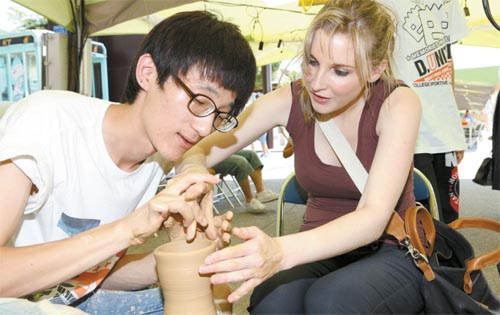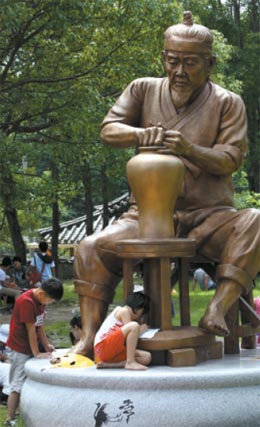At celadon fest, rhapsody in blue

Visitors make celadon at the Gangjin Celadon Festival in South Jeolla. Visitors can make their own pottery or try carving their own prints into the clay. [JoongAng Ilbo]
The majority of Goryeo Dynasty celadon was made in Gangjin, a seaside community in South Jeolla. Today, the area hosts an annual festival aimed at introducing visitors to the delicate blue-green pottery for which Korea is now famous.
The 39th Gangjin Celadon Festival features an exhibition, an auction and opportunities to make your own pottery as well as performances of traditional Korean music and dance. The festival has been named the best in Korea every year since 2002 by the Ministry of Culture, Sports and Tourism, and this year the ministry has designated it a national festival.
Gangjin, which was once located in the southern part of Goryeo (918-1392), was famous for its celdon production, and 188 of the nation’s 400 kilns are found there. Located near the southern coast, the city was also a convenient location for exporting celadon to other nations.
Goryeo celadon is known for its unique hues and a special inlay method called sanggam, both of which eventually came to distinguish Korean celadon from its Chinese and Japanese counterparts. In the sanggam technique, designs are engraved onto the pottery and the space is then filled with black or white clay, instead of printing the patterns on the surface of the porcelain. That makes the designs more prominent in contrast to the color of the porcelain.

A statue of a potter making celadon sits at the Gangjin Celadon Festival site.
Celadon is made by firing a piece of pottery for several days at 900 degrees Celsius (1652 degrees Fahrenheit). The piece is then glazed and fired again at more than 1,300 degrees Celsius for several more days to get the right color. Since there were no thermometers in the Goryeo period, it was hard to distribute the heat evenly to all of the pieces in the kiln, so only 20 percent of them would come out with the right color.
Nowadays, the pieces are fired with gas for the even distribution of heat. But potters attempting to make celadon using the traditional firing method still only see 70 percent of their pottery come out of the kiln looking the way they want it to.
For a look at finished celadon, head to “Goryeo Celadon, Returned to Gangjin.” The exhibition displays celadon originally made in Gangjin on loan from museums all over the nation. It runs until Sept. 30 at the Gangjin Celadon Museum, which is on the festival site. Included among the 52 pieces on display is a bottle printed with plum blossom flowers that is on loan from Seoul’s Horim Museum. Also on display are six pieces from Japan.
Buying one of these pieces could easily empty your pockets and then some, but visitors to the festival will have a chance to purchase celadon at a discount through a public auction. The auction is on Saturday and the initial asking price will be 50 percent off of the original price.
During the festival, visitors can also try carving their own print using sanggam inlay. Visitors carve their design onto a cup, dish or water jug and the finished piece will be delivered to your home address. The smallest cup costs 7,000 won ($6.65) and water jugs are around 22,000 won.
After the festival, a tour of the Gangjin area is also worthwhile. Gangjin is home to many historic Korean sites, including the home of Joseon-era scholar Dasan, or Jeong Yak-yong (1762-1836). He was exiled to Gangjin from Hanyang (present-day Seoul) from 1801 to 1818 based on the suspicion that he was the leader of a Christian movement. While in exile, Dasan studied silhak, or practical learning, and wrote more than 600 books. His home, also known as Dasan Chodang, is located on Mount Manduk. From there, he could look over to Heuksando, the home of his brother Jeong Yak-jeon, who was also in exile.
*The Gangjin Celadon Festival runs until Aug. 7 in Gangjin, South Jeolla. To get to Gangjin, take a bus to Gangjin Express Bus Terminal. From there, a free shuttle bus goes to the festival grounds every hour. Admission is 7,000 won. Call 1688-1305, or go to www.gangjinfes.or.kr.
By Lee Sun-min [summerlee@joongang.co.kr]
한글 관련 기사 [중앙일보]
30% 할인 가격에 고려청자를 소유할 기회, 놓치지 마세요
강진청자축제 기간(7월 30일~8월 7일)에는 청자 작품과 제품을 싼 값에 장만할 수 있다. 강진군이 운영하는 우리나라 유일의 관요(官窯)인 강진청자박물관 고려청자사업소뿐만 아니라 민간 요(27개)들이 축제를 기념해 원래 가격보다 30% 할인된 값으로 판매하기 때문이다. 강진 관요가 제작한 청자들은 축제장의 명품관과 박물관 안 전시판매장에서 살 수 있다.
특히 강진청자박물관에서 토요일마다 실시하는 경매를 활용하면 작품성이 있는 것들을 싼 값에 구입할 수 있다. 관요와 민간 도예가들이 빚은 것 가운데 박물관의 학예연구사들이 고르고 가격을 매긴 것을 경매에 부치기 때문이다.
이번 축제 기간의 경우 7월 30일과 8월 6일 오후 3시 청자 경매를 한다. 30일 박물관 시청각실에서 열리는 경매에는 정상가격 380만원인 물고기·용 모양 주전자부터 9만원인 주전자·잔 세트까지 모두 15점이 나온다. 8월 6일엔 화목가마에서 막 꺼낸 작품들을 즉석 경매할 예정이다.
경매는 정상 판매가격에서 50%를 할인한 가격에서 시작된다. 1인 응찰일 때도 낙찰되기 때문에 경합자가 없으면 반값에 손에 넣을 수 있다. 호가경매(呼價競賣) 방식이다. 보통 20만~30만원대에서 낙찰이 이뤄진다. 신상식 강진청자박물관장은 “좋은 작품 몇점을 싸게 경락받으면 여행 경비를 뺄 수 있다”며 “가스·전기가 아니라 장작 불을 때 전통방식으로 구운 화목가마 제품을 특히 눈 여겨 볼 필요가 있다”고 말했다.
강진청자박물관의 경매는 청자를 널리 보급하고 관광객을 유치하기 위해 2008년 6월부터 매주 토요일 열리고 있다. 15점씩을 경매에 부친다. 경매 대상 작품을 일주일 전부터 박물관 로비에 전시하고, 강진군 홈페이지에 소개한다. 문의 061-430-3712.










with the Korea JoongAng Daily
To write comments, please log in to one of the accounts.
Standards Board Policy (0/250자)